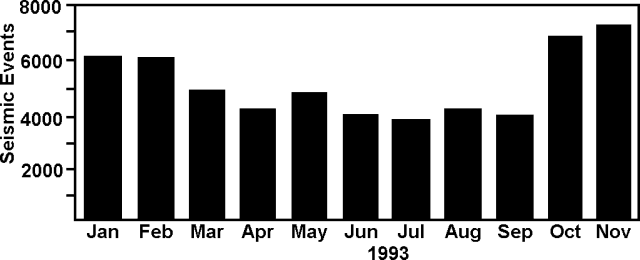Report on Poas (Costa Rica) — December 1993
Bulletin of the Global Volcanism Network, vol. 18, no. 12 (December 1993)
Managing Editor: Edward Venzke.
Poas (Costa Rica) Low-frequency earthquakes rise to highest levels of year, weak inflation
Please cite this report as:
Global Volcanism Program, 1993. Report on Poas (Costa Rica) (Venzke, E., ed.). Bulletin of the Global Volcanism Network, 18:12. Smithsonian Institution. https://doi.org/10.5479/si.GVP.BGVN199312-345040
Poas
Costa Rica
10.2°N, 84.233°W; summit elev. 2697 m
All times are local (unless otherwise noted)
Although October had the highest number of low-frequency earthquakes of any month thus far in 1993, November had still more (figure 46). The daily records of seismicity in October and November were dissimilar. Both months had a background near 100 events/day, but for October strong peaks in the record only became common in the last week. The November record looked more erratic, peaks took place every few days. In October peaks rose to 300-375 events/day; in November they rose higher, to 300-450 events/day.
 |
Figure 46. Seismic events at Poás received at a station 2.7 km SW of the active crater (POA2), January-November 1993. Courtesy of OVSICORI. |
The surface of the northernmost crater lake at Poás rose 50 cm in November. This 200-m diameter crater lake also had subaqueous fumaroles. In November some of the fumaroles were in the NE part of the lake, and others bubbled constantly in the lake's center. The turquoise-green lake water contains suspended clouds of sulfur. Its temperature dropped slightly, from 63°C in late May to 60°C in November. Temperatures in the early-1980's were in the range 40-60°C. From 5 August to 26 October the deformation circuit around the active crater lengthened an average of 15 ppm.
Geological Summary. The broad vegetated edifice of Poás, one of the most active volcanoes of Costa Rica, contains three craters along a N-S line. The frequently visited multi-hued summit crater lakes of the basaltic-to-dacitic volcano are easily accessible by vehicle from the nearby capital city of San José. A N-S-trending fissure cutting the complex stratovolcano extends to the lower N flank, where it has produced the Congo stratovolcano and several lake-filled maars. The southernmost of the two summit crater lakes, Botos, last erupted about 7,500 years ago. The more prominent geothermally heated northern lake, Laguna Caliente, is one of the world's most acidic natural lakes, with a pH of near zero. It has been the site of frequent phreatic and phreatomagmatic eruptions since an eruption was reported in 1828. Eruptions often include geyser-like ejections of crater-lake water.
Information Contacts: E. Fernández, J. Barquero, R. Van der Laat, F. de Obaldia, T. Marino, V. Barboza, and R. Sáenz, OVSICORI.

